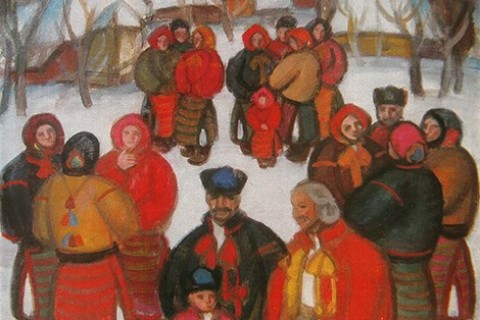
Winter holidays in the works of the Transcarpathian artists
2019

For numerous people since their childhood winter is primarily associated with holidays, fulfilment of wishes and hopes for the coming year. The contemporary people celebrate magnificently thanks to fireworks and bright illumination, but the latest technologies and urbanization, unfortunately, do not contribute to preserving those deep-seated motifs that were founded by our ancestors in festive traditions.
Artists who subtly feel the beauty and spirituality of folk festivals, created rich plot compositions, fully recreate the atmosphere of folk traditions and carry us in times of the past.
The spirit of Christmas with its funny holidays and a truly frosty snowy winter give us the paintings of a talented artist Yurii Herts. Looking at them, we feel their positive mood.

One of the most famous Transcarpathian painters, who depicted the holiday ceremonies and the life of peasants, was Fedir Manailo. The artist travelled around Transcarpathia, thoroughly studying folk traditions, rituals and making sketches from the inhabitants of the region, which formed the basis of his numerous canvases full of love and respect for the culture of the people of his native land.
A lot of works by the artist are devoted to Christmas. One of them is the composition “Koliada”. As an art historian Viktoriia Manailo-Prykhodko describes, the composition is built in a circle – an ancient symbol of the life cycle, a symbol of the Sun, which our ancestors called Koliada. Koliada celebrates the beginning of a new year of rotation of the Earth around the Sun. Ancient man believed that the world is opened at this night (the world of gods – heaven, the world of a man – the earth, the world of underground wealth and dead ancestors – underworld).

Koliada's circle placed in the quadrangular format of the canvas is a symbol of Cosmos, and in the four corners of the canvas are symbols of good and evil, building and disorder (angel and witch), day and night, dark and light (Sun and Moon) are the basis of beliefs and ideas about the universe. These symbols in small rings - like four points in the corners of the quadrilateral – are coded information about the “sown field”, this is a filled world, balanced in chaos and order. In the very circle, there is a traditional ritual act: livestock is fed to be well-fed throughout the year, dressed people walk from house to house with betlehem, playing various scenes, the family dines at the table, and in the corner, there is a “didukh” - a symbol of a good harvest.

In this cycle, the period of hard work is changed to a period of rest: the pantries are filled with harvested crops, cattle is fed. It is time to celebrate until the Great Lent comes.

According to historians, the Gentiles celebrated “return of the Sun” on the day of the winter solstice and Christians chose this day to celebrate their biggest holiday – Christmas.
Looking at the canvas of the People's artist of Ukraine Taras Danylych, we immerse ourselves in the very ritual performance of the Christmas Eve.

Starting with Christmas Eve, carol singers walk from house to house, singing songs and announcing the birth of Christ. They also wish happiness, health and well-being, for which they are given sweets and money. According to folk tradition, it is believed that the more carol singers visit the house, the more generous the year will be for the family.
Mandatory attribute of carol singers – a big star on a stick that symbolizes a Bethlehem star, which marked the birth of Christ.

According to the Transcarpathian tradition, early on Christmas Day, the first carol singer should be a young man ort betlehemy. It’s done for good luck so that the whole year will be lucky.

Text: Liudmyla Kozlovska
Photos of works are from open sources
© Art & Culture Foundation Brovdi Art
